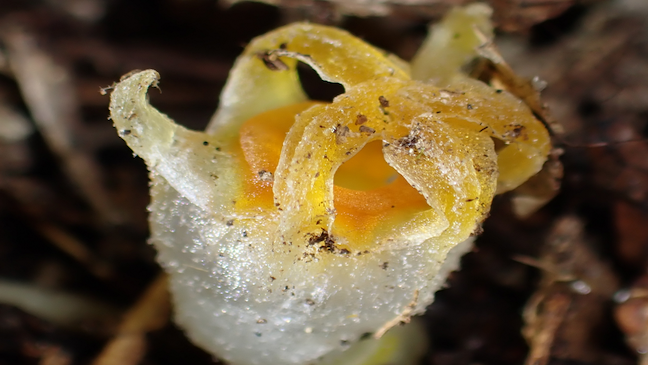Otherworldly 'fairy lantern' plant, presumed extinct, emerges from forest floor in Japan
The mysterious plant, Thismia kobensis, was rediscovered growing a few inches from a forest floor in Japan.

Scientists in Japan have rediscovered an extremely rare species of parasitic "fairy lantern" that was presumed to be extinct.
The mysterious plant, Thismia kobensis, belongs to a rarely seen, fungus-sapping genus. The plants grow underground without photosynthesis yet send translucent flowers to sprout like ghostly lanterns from the forest floor.
First documented in 1992 in Kobe, Japan, the plant was presumed extinct when its habitat was destroyed by the building of an industrial complex. Now, three decades later, on a forest trail about 19 miles (30 kilometers) from Kobe, scientists have found the waxy, fang-shaped petals of the rare plant once more. They described the discovery Feb. 27 in the journal Phytotaxa.
Related: Some carnivorous plants evolved to eat poop instead of bugs. And they're better off for it.
"This unexpected find and subsequent investigations have shed new light on this remarkable genus and its evolutionary history," the researchers wrote in a statement.
Fairy lanterns (Thismia) are ethereal, subterranean plants whose only brief eruptions from the earth come in the form of intricately petaled flowers. Without chlorophyll to photosynthesize energy, the plants instead use a process called mycoheterotrophy to steal the nutrients from the fungi that entwine themselves around their roots.
Thismia's preferred habitats, which tend to be tropical rainforests, are facing global decline. Little is known about the elusive plants, and a significant number of the roughly 90 identified species have been lost, some for decades, after their initial discoveries.
Get the world’s most fascinating discoveries delivered straight to your inbox.
"Because most mycoheterotrophic plants obtain their carbon indirectly from photosynthetic plants via shared mycorrhizal [fungal and plant] networks, they are highly dependent on the activities of both the fungi and trees that sustain them," the researchers wrote in the study. "Consequently, they are particularly sensitive to environmental disturbances, often rendering them both rare and endangered."
The rediscovery of T. kobensis makes it the northernmost known Asian fairy lantern species. After studying the otherworldly plant, the scientists found that its features, such as its distinct petals and lack of nectar glands, make it closely related to the only North American fairy lantern, Thismia americana.
The researchers think T. kobensis is a descendent of T. americana, which might have crossed from North America to East Asia over the Bering Land Bridge. T. americana was first found in Chicago in 1912 but has not been seen since 1916.

Ben Turner is a U.K. based writer and editor at Live Science. He covers physics and astronomy, tech and climate change. He graduated from University College London with a degree in particle physics before training as a journalist. When he's not writing, Ben enjoys reading literature, playing the guitar and embarrassing himself with chess.


